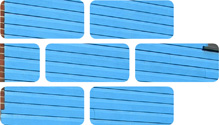
Plastic Cladding Plastic 17 02 03
Plastic cladding and associated fascias, barge, corner, cavity and ridge boards are commonly made from polyvinyl chloride (PVC). The materials are extruded or moulded into a range of box or corrugated profile shapes in various styles, sizes, colour, quality and thickness depending on the specification required, intended use and architectural finish.
Usage & Probable Locations
Plastic cladding is used as an external cladding to walls, gables and infill between walls and frames. They provide an external clad finish to an internal block wall or timber frame and is commonly laid horizontal across the building. It is frequently interconnected with rainwater systems, windows, doors and garage doors.
Personal Protective Equipment
PPE requirements indicated are for guidance purposes only. DRIDS has identified the PPE that is mandatory on all demolition projects and ones that may be required subject to site specific Risk Assessment & Method Statement (RAMS). Hover over the icon to determine the types of PPE required for the removal of this material.
Removal, Segregation & Storage
Plastic cladding is used as an external cladding to walls, gables and infill between walls and frames. They provide an external clad finish to an internal block wall or timber frame and is commonly laid horizontal across the building. It is frequently interconnected with rainwater systems, windows, doors and garage doors.
Tools
Fixtures, Fittings & Connections
Plastic cladding has been traditionally fixed in place with clout nails, screws and staples and sealed with a suitable silicone sealant or mastic. Rainwater systems may be fixed with brackets, screws or bolts and the fascias, barge, corner, cavity and ridge boards around windows, doors and walls will be fixed using a range of brackets screwed or nailed in place. Cladding is rarely painted, coated or protected as the PVC is a reasonably durable product, although may become brittle over time.
Health & Safety
Subject to task-specific Risk Assessment & Method Statement (RAMS). Use correct protective equipment for removing screws, nails, sealants and brackets. Wear gloves when handling cladding coated in glues or adhesives to prevent irritation and cuts. Wear eye protection when removing fixings with a crowbar, hammer or chisel. Limit hand, arm and whole body vibration. Use harness protection at height. Only use cutting tools, 360 plant and attachments if properly trained.










